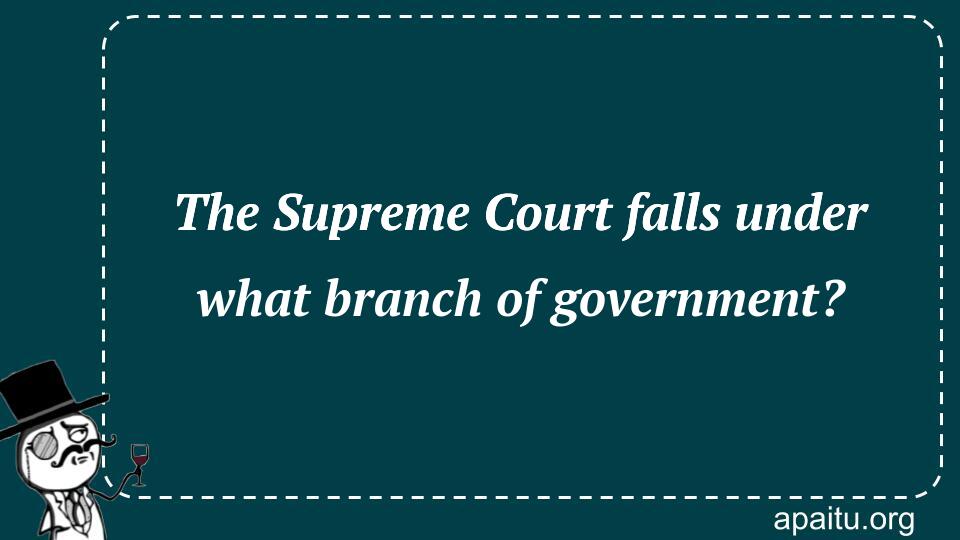Question
Here is the question : THE SUPREME COURT FALLS UNDER WHAT BRANCH OF GOVERNMENT?
Option
Here is the option for the question :
- Legislative
- Judicial
- Executive
- Military
The Answer:
And, the answer for the the question is :
Explanation:
The French philosopher Montesquieu first used the phrase “separation of powers” in the 18th century, and the U.S. Constitution’s founding fathers strongly endorsed it. As part of this system of checks and balances, the Constitution established the legislative, executive, and judicial branches. The Supreme Court is a part of the judicial branch, according to Article 3 of the document.

The United States government is structured into three distinct branches: the legislative, executive, and judicial branches. Each branch has its own unique responsibilities and powers, ensuring a system of checks and balances. When it comes to interpreting the law and ensuring its constitutionality, the Supreme Court of the United States plays a pivotal role. As the highest court in the land, the Supreme Court falls under the judicial branch of government.
The judicial branch is responsible for interpreting and applying the law, as well as resolving disputes in accordance with legal principles. Its primary function is to administer justice and uphold the rule of law. The Supreme Court, as the apex of the judicial branch, holds the ultimate authority in matters of constitutional interpretation and has the power to make binding decisions that shape the legal landscape of the nation.
The Supreme Court is composed of nine justices, including one Chief Justice and eight Associate Justices. These justices are appointed by the President of the United States and confirmed by the Senate. Once appointed, they serve for life unless they choose to retire or are impeached and removed from office. This lifetime tenure ensures judicial independence and insulates the justices from political pressures, allowing them to make impartial decisions based on the merits of each case.
One of the Supreme Court’s most significant responsibilities is to review and rule on cases that involve constitutional issues. The Court acts as the final arbiter on matters of constitutional interpretation, ensuring that laws and government actions align with the principles outlined in the United States Constitution. Through a process known as judicial review, the Court determines whether laws passed by Congress or actions taken by the executive branch are consistent with the Constitution. This power of judicial review grants the Supreme Court the authority to strike down laws deemed unconstitutional, shaping the legal framework within which the government operates.
When a case reaches the Supreme Court, it is typically because it raises significant legal questions or involves conflicting interpretations of the law. The Court carefully selects cases that will have a broad impact on the legal system or address important societal issues. The decisions rendered by the Supreme Court have far-reaching consequences, setting legal precedents that guide lower courts and shape future interpretations of the law.
The Court’s decisions are made through a process of deliberation and debate among the justices. Justices review legal briefs, listen to oral arguments presented by the parties involved, and engage in rigorous discussions before reaching a decision. The Court’s rulings are typically expressed through majority opinions, which outline the legal reasoning behind the decision. In some cases, justices may also write dissenting opinions, expressing their disagreement with the majority’s interpretation of the law.
The Supreme Court’s decisions have shaped the course of American history and have had a profound impact on civil rights, social issues, and the balance of power between branches of government. Landmark cases such as Brown v. Board of Education, Roe v. Wade, and Obergefell v. Hodges have fundamentally altered the legal landscape and influenced societal norms.
the Supreme Court falls under the judicial branch of the United States government. As the highest court in the land, it is responsible for interpreting the law, ensuring its constitutionality, and resolving disputes. The Court’s decisions have far-reaching implications and play a crucial role in shaping the legal framework of the nation. Through its authority to review and rule on cases involving constitutional issues, the Supreme Court safeguards the principles outlined in the United States Constitution and ensures the proper functioning of the American legal system.